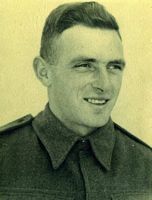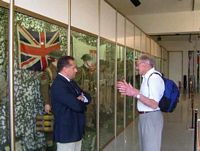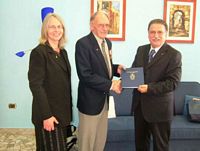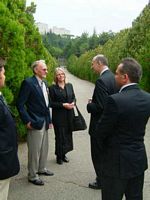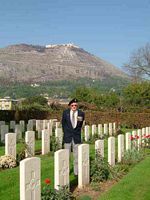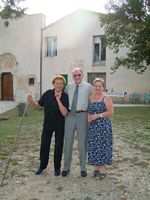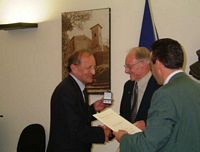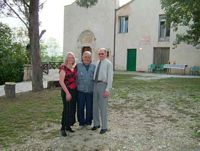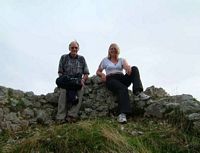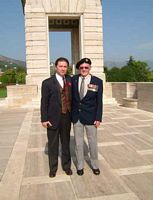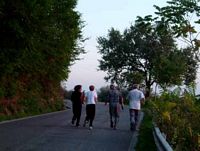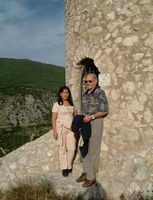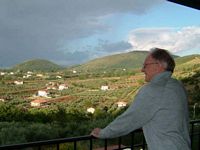Data: 17/04/2005
 Autore: KAY DE LAUTOUR
Autore: KAY DE LAUTOUR Liste: ARTICLES IN ENGLISH
Liste: ARTICLES IN ENGLISH Categorie: Testimonianze
Categorie: Testimonianze Tag: #today, nuova-zelanda, veterani-reduci
Tag: #today, nuova-zelanda, veterani-reduciROME CAN WAIT
“He aha te mea nui o tenei ao? Maku e kii atu, He tangata, he tangata, he tangata!”
“Mi chiedi quale sia la cosa più importante in questo mondo? Te lo dirò: sono le persone, sono le persone, sono le persone!”
Eric de Lautour was a driver in Divisional signals attached to A Squadron, 18th Armoured Regiment, NZEF. He initially served as an infantryman in the
25th Battalion in North Africa. In his first action there he witnessed the death of fellow soldiers in the trenches. But it was also in Tunisia that
he first saw a Roman wall, this particular one being in the desert where military action took place. Later he experienced Rome itself first hand while
on leave in Italy. He still marvels at the having the whole Sistine Chapel to himself late one afternoon thanks to his cigarette ration (he being a non
smoker) and a grateful custodian.
While he was still a Lance-Corporal he was “claimed” away from the front line by his older brother, relinquishing his rank to join the Engineers unit
in Benghazi. From there it was to training school in Maadi Camp, and in February 1944 he was sent on to Italy.
Eric came to Italy from Alexandria on a Polish ship, the Sobiesky. It was a big convoy of ships, destroyers, and a lot of aircraft overhead that went
through the Straits of Messina and in to Naples. Coming into Italy he saw two active volcanoes, Stromboli and Vesuvius. The poverty he saw on landing
in Naples, with beggars in the streets and starving children, is a memory still strong today.
From Naples he went to a base near Bari, then Eric joined the 18th Armoured Regiment at Mignano south of Cassino. The first action he saw in Italy,
as in Tunisia, resulted in the death of two soldiers near him. This occurred close to Mount Trocchio, prior to the final battle for Monte Cassino.
Early in April tanks were firing near Mount Trocchio, and the Germans returned fire with a big gun. Eric and Selwyn Judge were in a dug-out under the
trees on the side of the road. The first shell exploded underground, they could feel the movement but there was no crater. The second fell near the
tanks, killing the two men nearby. The third fell in front of Eric and Selwyn Judge’s dug-out and car and covered the vehicle and the dug-out with
layers of mud. Both men got out with difficulty and were quite shocked for a while. They realised that if the shell had hit their vehicle they would
have been killed. The understated record of this event in Eric’s war diary reads “Quiet morning. Shelled in afternoon. One landed by nose of car.
Roof of dugout came in. Car wheels turned 40º! Dirt all over. Back to new area after dark.”
Eric continued to serve with the 18th Armoured Regiment until he became ill at Forli, being hospitalised at Caserta for 5 months before returning
to New Zealand on the Dutch hospital ship Oranje.
Italy Revisited 60 years on…
From 7 October until 7 November 2004 my father, Eric de Lautour, revisited Cassino and the surrounding areas. The beauty of the countryside, now peaceful and productive, the Melfa Gorge (a runner’s delight) and the people, in particular our wonderful hosts and friends, made this a trip of a lifetime. “We were privileged people,” says Eric, reflecting on the many wonderful memories from this viaggio, our father-and-daughter visit to the Ciociaria region in Italy.While preparing for this visit I asked him what he wanted to see and do in Italy. It seemed to me that re-tracing his war-time steps was the logical thing to plan and, of course, the spectacular sights of the Eternal City must also hold great appeal. His response was much more simple, yet much more profound. During WWII it was the cheerfulness and the attitudes of the people that formed his lasting memories of Italy. On this viaggio my father wanted to know not so much about the places, knowing well that they must change in 60 years, but about the people. What had happened to the children, some of whom were so hungry 60 years ago? Did the spirit that he had observed in wartime Italy 60 years ago survive in the following generations? Was Italy still a place of cheerful people, did laughter and children’s voices still ring in the air? And, of course, we would go to Rome, and also to Caserta where he was in hospital for five months.
Veroli and Roccasecca were districts of particular interest; Veroli because Eric was based there for 35 days during a rest period, and Roccasecca because a particularly vivid memory was the spirit of the people, seen when he observed the villagers rebuilding Ponte Vecchio, the bridge of “Spirito Santo” near the Melfa Gorge. General opinion was that “Europe was finished” but Eric remembers thinking that with such community spirit, with every available person from young to old helping rebuild the bridge, there was still a strong future for Italy. Correspondence with historians from these areas was also a contributing factor in the decision to make this trip, so for over a month we were based at Roccasecca and explored the area with the generous help of our Italian friends.
During the war, and particularly when camped at Veroli, Eric frequently walked and hitch-hiked to different towns to visit his brothers and friends in other units. Although he was fascinated by the rock walls and structures, while visiting these small towns in 1944 he was unaware of the beauty inside the towns and churches. Our excellent historian friends remedied this; thanks to Alessandro Campagna, Roberto Molle and Gianni Blasi we were privileged to not only see these wonders but to learn so much about the history of the people, the towns and the buildings.
A recurring theme in the stories I remember my father telling was of the children in Italy. To be greeted by one of the hungriest of these children, and to hear his story, was a particularly poignant moment in this journey. Benedetto (Ben) Malnati was a child during WWII, starving in a cave in the Melfa Gorge. Ben remembers well the NZ soldiers giving his family white bread and chocolate. His subsequent story is evidence of the spirit of the people. Ben left Italy, lived in Wales and England, then returned to his home with his Italian wife and UK-born children. Hearing this story, and the gratifying stories of the success of his children, justified Eric’s optimism in the future of Italy at a time when everyone was pessimistic about the fate of Europe.
A farmer himself, Eric was interested in the land-use and farming methods. Looking back now he observes the changes. Within approximately thirty years post-war, farming and horticulture processes seemed to have jumped one hundred and fifty years. In war-time Italy the methods were almost like those from Biblical times, with intensive hand-labour practices, but now, without the process of evolution which occurred in other places, they are up with and sometimes ahead of world wide practices. In 1944 many children were working on the farms, one vivid memory being of a very small girl leading a very large bull out to pasture. He saw a boy taking sheep up a hill, playing a tune on a home-made willow whistle. Children would come to the well to get water, and help one another to get the heavy water onto the cloth on their heads. If there were soldiers the children made signs for the soldiers to lift the water onto their heads for them. Eric learned a lot of his Italian from talking to children. The children would laugh if he got it wrong and tell him how to say things.
The singing of over 10,000 Polish soldiers in a transit camp in Egypt had been a particularly moving experience, and soon the Kiwi tanks were supporting the Polish soldiers in the attack on Monte Cassino. Visiting the Polish cemetery near the abbey on Monte Cassino was an emotional occasion as we reflected on the lives wasted and the futility of war. Yet there seemed to be no doubt that the war needed to be fought. Italians asked Eric why soldiers came from the other side of the world to help in this war; how did it feel to be fighting so far from home? Even as far away as New Zealand was, the Axis powers were carving up the world and New Zealand was destined to be a German colony. Going to war, even on the other side of the world, was seen to be a necessity, not just an adventure.
During our time in Cassino we were able to attend a service at the Polish monument at Piedemonte San Germano, and other functions in Cassino and Roccasecca. On 26 October the Canadian commemoration ceremony at the Commonwealth Cemetery was a dignified and particularly well-conducted service, in French and English, honouring the fallen soldiers. This was concluded with powerful renditions of the Canadian and Italian national anthems.
Ceremonies at the Melfa River were wonderful examples of the spirit of friendship between the Italian people and the Allied Forces. Our hosts continued to amaze us as they worked into the night organising events and then left their workplaces by day to host visiting veterans (Eric had noted that the Melfa river bed was much higher with 60 years of rocks and stones washing down into it. The busloads of Canadians did their bit to remedy this by selecting stones as souvenirs to take home to Canada!)
Visits to the Cassino War Museum were never quite long enough as there was so much to see and reflect on. It was good that we were able to return there on several occasions. For Eric it was a chance to see familiar objects again, to look at the opposing armies more closely, but more particularly to read the stories that complement the exhibits. For me the photographs were the most important exhibits; now I could put real faces into the stories I have read. It is the faces of the civilians looking out from the photographs that I will always remember.
The Melfa Gorge was a delight to be discovered. During the war the A Squadron was not engaged in the gorge itself, but moved on from Roccasecca in the direction of Rocca d’Arce. On this visit, however, the gorge was a geographical highlight! A veteran athlete and dedicated runner, Eric made the most of his time walking and running in the gorge each day. This proved to be both a pleasure and a challenge, and before the visit was over he had run the high altitude 25 kilometre return trip from Roccasecca to Santo Padre – certainly not something he did in war-time!
Our accommodation, Agriturismo Felicetta, was beautifully placed at the mouth of the gorge. It had not taken long to feel completely at home there and our hosts became good friends. Card games, some singing and a lot of laughter, along with the care they took to meet all our needs, added to the sense of belonging. We had our own key and were calling Felicetta “home”. Our regular trips to the all-purpose tabacchi, the fruit shop where, among other things, we bought New Zealand kiwifruit, and the daily greetings from locals as we walked in the gorge meant we felt a part of the community in Roccasecca.
The decision to be based mainly in one place had been a good one. We had made some very good friends, and we became very reluctant to move on. But time was running out. “Should we take a train to Caserta?” I asked occasionally. “Did you want to go back to Rome?” The answer was always the same. Why would we leave this beautiful place and shorten our time with these wonderful people to visit a city? “Next time,” replied my Dad. “We will go to Caserta next time.” And Rome? Rome can wait!
Nel caso in cui il testo derivi sempicemente dall'esposizione, con o senza traduzione, di documenti/memorie al solo fine di una migliore e più completa fruizione, la definizione Autore si leggerà A cura di.
Articoli associati
QUELLA CORSA VERSO LA STAZIONE SOTTO UNA PIOGGIA DI FUOCO (17 MARZO 1944)
Delle quattro battaglie combattute a Cassino nel 1944, la terza é sicuramente quella con il maggior numero di episodi tattici ben distinti tra loro. Ciascuno di essi costituisce una piccola storia fatta di lotta, coraggio e sacrificio, come l’attacco neozelandese verso la stazione ferroviaria di Cassino.
29/11/2005 | richieste: 16373 | LIVIO CAVALLARO
ARTICLES IN ENGLISH | Le battaglie | #marzo 1944, cassino, nuova-zelanda
Il 20 maggio 2004 si proponeva come una tipica giornata d’inizio estate: calda e umida. Nel primo
pomeriggio il Primo Ministro Neozelandese Helen Clark, arriva al Cimitero “Inglese” di Cassino, per ricordare i
caduti di quei tragici giorni del 1944. Tra i tanti che caddero, anche gli uomini del 28° Battaglione Maori...
23/07/2004 | richieste: 9977 | VALENTINO MATTEI
ARTICLES IN ENGLISH | Cronache | #today, manifestazioni, maori, nuova-zelanda
LA SECONDA GUERRA MONDIALE A ROCCASECCA - NEOZELANDESI
Terminati i combattimenti sul fronte di Cassino, i Neozelandesi fraternizzarono con la popolazione locale; eccone un esempio.
29/09/2001 | richieste: 11911 | ROBERTO MOLLE
ARTICLES IN ENGLISH | Spigolature | #marzo 1944, #giugno 1944, #today, civili, nuova-zelanda

